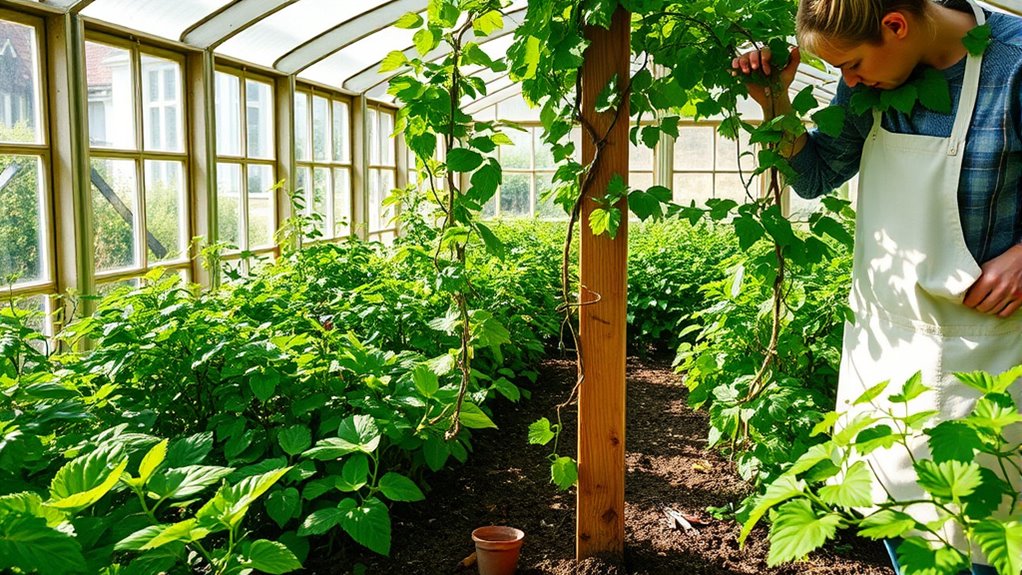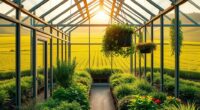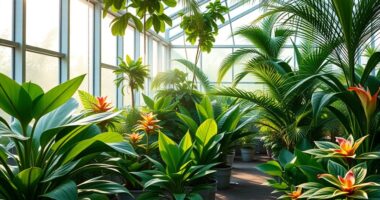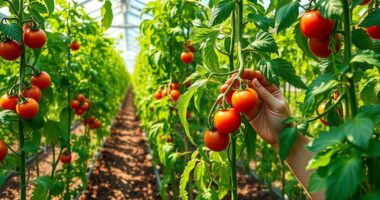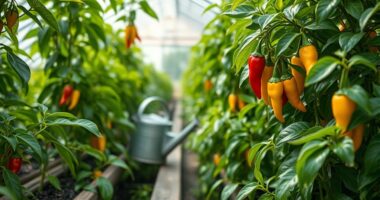Pruning and training your plants in a greenhouse is essential for boosting their health and productivity. You'll want to prune during the dormant season to reduce stress. Using the right tools helps maintain clean cuts, and regular techniques can enhance air circulation and nutrient allocation. Training your plants improves their growth potential, adapting your methods to specific crops can yield better results. Stick around to discover effective techniques tailored to your greenhouse garden!
Key Takeaways
- Prune during the dormant season to reduce stress and enhance plant health in the greenhouse.
- Use specific pruning tools like bypass shears and loppers for effective cuts on various plant sizes.
- Employ tailored pruning techniques for each crop to maximize yield and promote healthy growth.
- Maintain hygiene by disinfecting tools between cuts to prevent disease spread among plants.
- Consider environmental factors, such as humidity and temperature, when scheduling pruning activities.
Importance of Pruning in Greenhouse Gardening
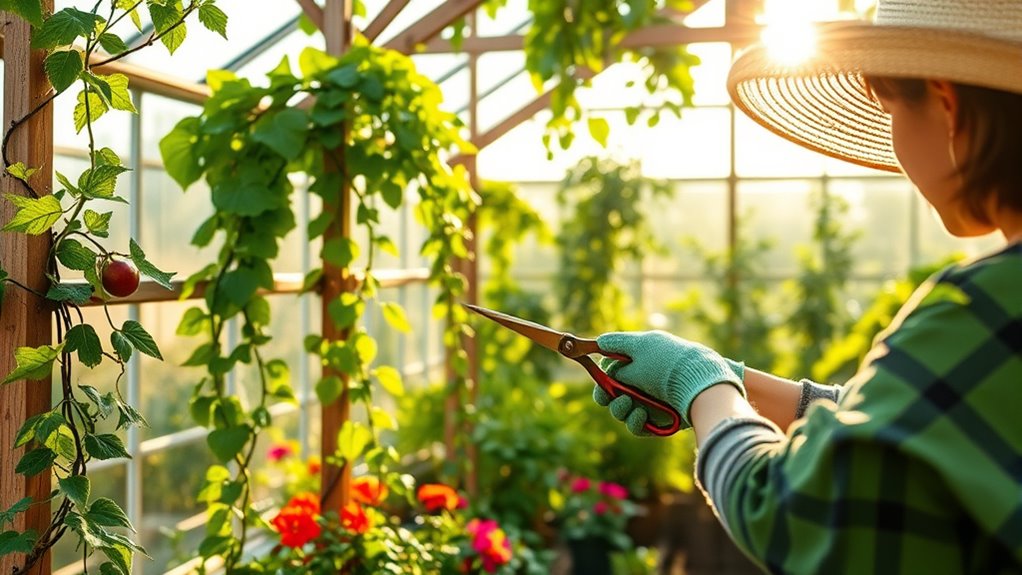
While you might be tempted to overlook pruning in your greenhouse gardening, it plays a crucial role in maintaining plant health and productivity. Pruning removes dead, diseased, or damaged parts, improving overall plant health and reducing disease risk.
By enhancing air circulation, it helps prevent fungal infections and promotes new growth, making your plants stronger and more resilient. Regular pruning also manages pest infestations by eliminating hiding spots for pests, ensuring that each plant receives adequate nutrients.
This focused approach means more energy goes to healthy parts, resulting in increased fruit and flower production. Ultimately, pruning not only supports plant vigor but also maximizes your greenhouse space and resources, keeping your garden thriving.
Optimal Timing for Pruning
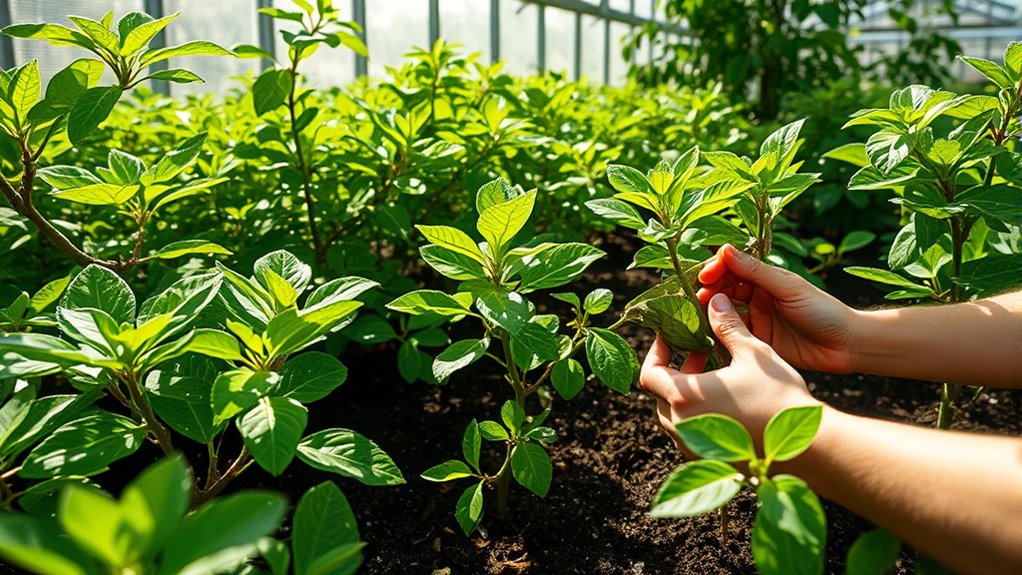
Understanding ideal timing for pruning is essential for ensuring your greenhouse plants thrive. Pruning during the dormant season helps minimize stress on your plants.
Different species have specific needs—grapevines, for instance, should be pruned mid-winter to prevent sap bleeding, while evergreen shrubs benefit from late winter pruning.
Avoid late summer and early fall for pruning, as new growth may not harden off before winter arrives. Always consider environmental factors, like frost, which can impact your timing.
Prune diseased or damaged parts anytime to protect plant health. By being mindful of these factors, you'll create an excellent environment for your plants and encourage healthy growth throughout the seasons.
Essential Pruning Tools and Hygiene Practices
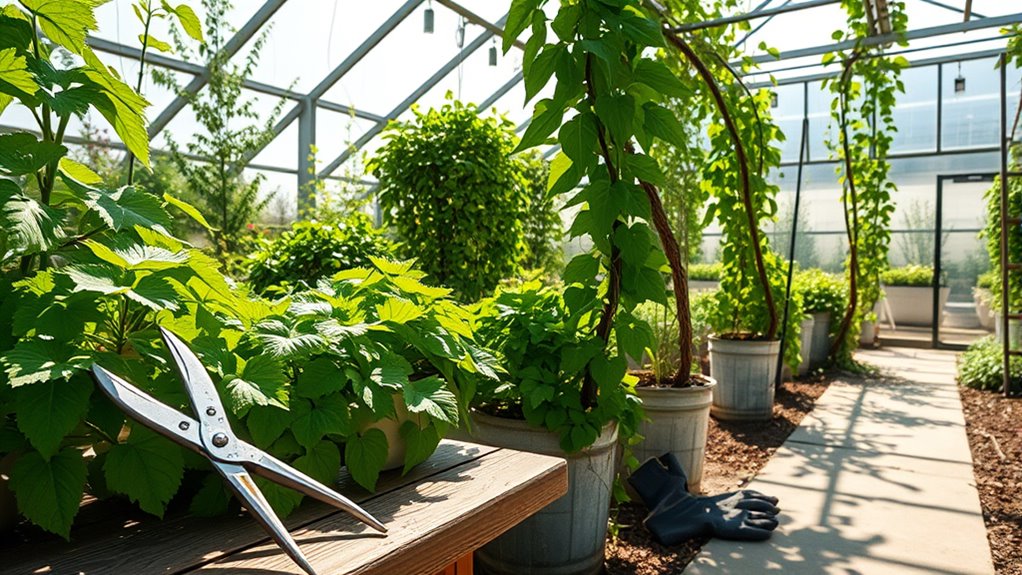
Pruning tools play an essential role in maintaining the health and shape of your plants. You'll need bypass shears for clean cuts on smaller branches, loppers for thicker ones, and pruning saws for larger limbs.
For high branches, consider pole pruners, while hedge shears help you tidy up hedges efficiently.
Maintaining hygiene is vital, too. Always disinfect your tools between cuts, especially when working with diseased plants, using a 10% bleach solution.
Regularly clean your tools to prevent rust and keep them sharp for clean cuts. Proper storage extends their lifespan.
Effective Pruning Techniques for Various Crops
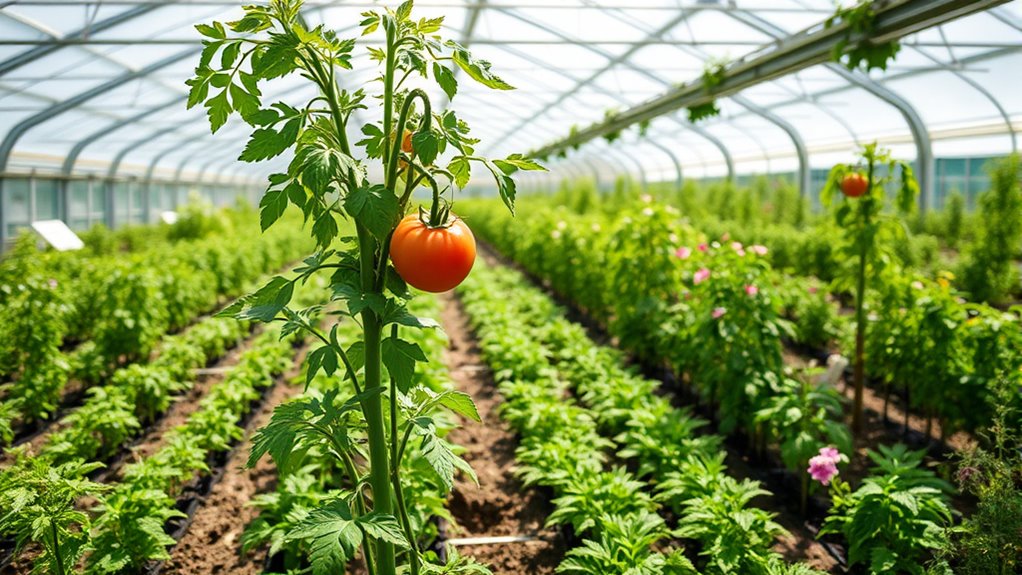
When you implement effective pruning techniques, you can greatly enhance the health and productivity of various crops.
For indeterminate tomatoes, remove suckers weekly and lower leaves biweekly to boost air circulation and energy allocation.
With sweet peppers, prune the growth point after 15 inches and alternate removal of side shoots and flower clusters to foster a strong structure and manage fruit load.
For cucumbers, employ pruning systems like the umbrella renewal system while ensuring you maintain adequate leaf area for ideal yield.
Overview of Training Methods for Greenhouse Plants
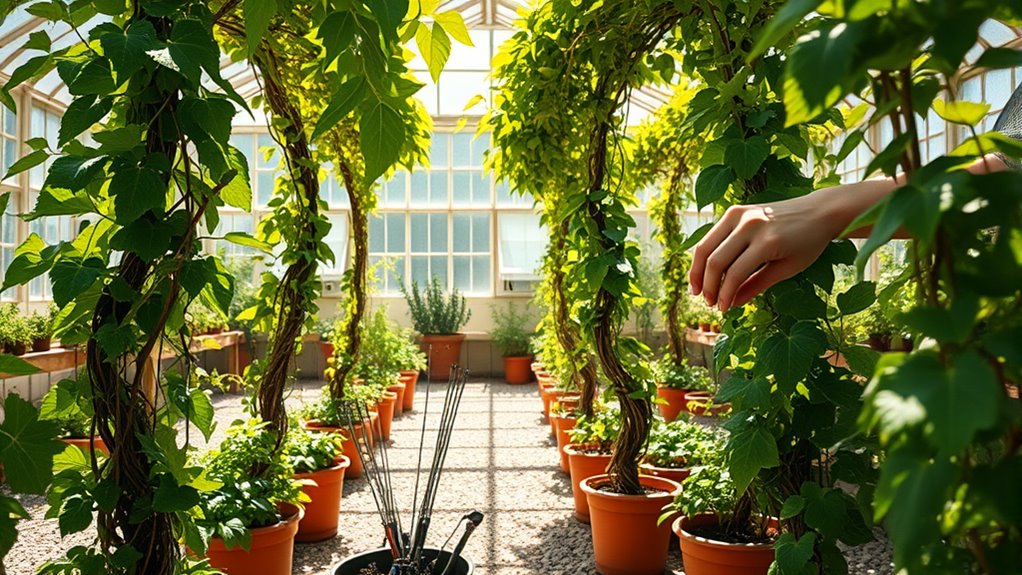
Effective training methods for greenhouse plants are essential for maximizing growth and yield.
For vining crops like cucumbers, you can use the drape, umbrella, or v-cordon methods to enhance light exposure.
When it comes to tomatoes, layering or leaning and lowering techniques help manage stem growth effectively.
For peppers and eggplants, focus on vertical growth without lowering the plants to prevent damage.
In indoor systems, techniques like Low-Stress Training (LST) and Screen of Green (SCROG) promote horizontal growth and maximize light.
Don't forget about trellising and canopy management to guarantee even growth.
Always use clips and strings for support, as they guide stems upward and balance growth, adapting methods based on seasonal conditions for ideal results.
Benefits of Training and Pruning for Plant Health

While you may not realize it, training and pruning your plants can greatly enhance their health and productivity. By removing diseased or damaged parts, you improve disease resistance and reduce the risk of pest infestations.
Pruning also frees up nutrients for healthy growth, leading to increased yield and better fruit quality. With proper training, you encourage controlled growth patterns and guarantee even fruit distribution, making harvesting easier.
Additionally, enhanced air circulation and sunlight penetration promote vigorous growth, while a strong structural framework reduces branch failure risks. Overall, these practices not only improve plant aesthetics but also contribute to longer plant lifespans, helping you create a thriving greenhouse environment.
Crop-Specific Training Techniques
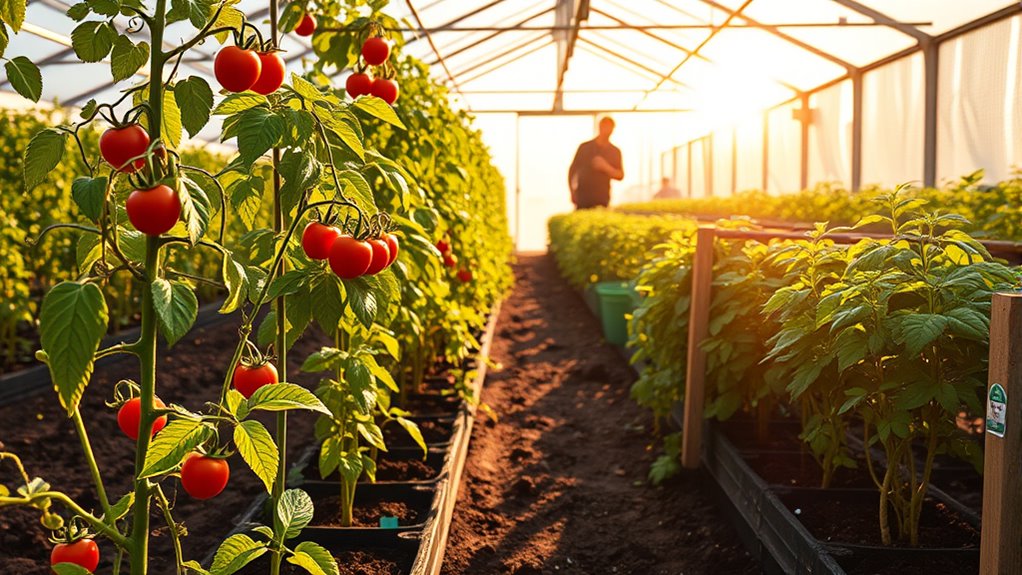
To maximize the health and yield of your plants, understanding crop-specific training techniques is essential.
Maximizing plant health and yield requires a deep understanding of crop-specific training techniques.
For tomatoes, use layering or leaning and lowering methods to enhance both yield and health.
When growing peppers and eggplants, train them upwards to avoid damage.
Cucumbers benefit from the drape, umbrella, or v-cordon methods, promoting ideal light interception.
Strawberries require runner pruning to focus growth on fruit production.
Leafy greens and herbs generally don't need training due to their quick growth cycles.
For vining crops, consider trellising or cable trellises to support vertical growth, which increases density and light exposure.
Tailoring your approach to each crop will guarantee a thriving greenhouse environment.
Environmental Considerations for Pruning and Training

Understanding environmental considerations is essential for successful pruning and training, as these factors greatly impact plant health and productivity. You should prune when temperatures are stable to minimize stress on your plants.
High humidity can lead to disease, so pruning improves air circulation and helps maintain a healthy environment. Guarantee even light penetration by removing lower leaves, which also enhances air flow and reduces disease risk.
Regularly monitor for pests and sanitize your tools to prevent disease spread. Pruning optimizes light and water usage, directing nutrients to productive parts of the plant.
Finally, adjust your pruning techniques based on seasonal changes and local climate conditions to protect your plants and maximize their growth potential.
Frequently Asked Questions
How Often Should I Prune My Greenhouse Plants?
You should prune your plants regularly to keep them healthy and looking their best.
Depending on the type of plants and their growth stage, you might need to prune weekly during the growth season. Focus on removing dead or diseased branches, as this boosts overall health and encourages new growth.
As plants slow down, you can reduce the frequency, but always be ready to trim any problematic areas whenever necessary.
Can I Use Household Tools for Pruning?
Using household tools for pruning is like trying to cut a steak with a butter knife—it's possible, but not ideal.
You can use scissors or a sharp knife for small tasks, but they may not give you the precision needed for plant health. Rust risks and lack of durability can also be issues.
Investing in specialized pruning tools will make your job easier and keep your plants thriving.
What Signs Indicate That a Plant Needs Pruning?
You should look for several signs that indicate a plant needs pruning.
If you notice dead or dying parts, it's time to remove them to prevent spreading disease.
Check for overgrown foliage blocking light or air, which can hinder growth.
Additionally, broken or crossing branches can pose safety risks.
Keep an eye out for discoloration or cracks in the bark, as these may signal underlying problems that require your attention.
Is There a Specific Order to Prune Different Plants?
Absolutely, there's a specific order to prune different plants.
Start with removing any dead or damaged material first, as this helps prevent disease.
Next, focus on thinning out crowded areas to improve airflow and light penetration.
After that, prune for shape and size, considering the plant's growth habit.
Finally, always sanitize your tools between plants to avoid spreading any potential diseases.
Following this order guarantees healthy growth and ideal results.
How Do I Recover a Plant After Over-Pruning?
If you've over-pruned your plant, don't panic.
Start by ensuring it gets plenty of water, especially in warmer conditions.
Apply a balanced fertilizer to boost its recovery.
Remove any dead or damaged areas to encourage healthy growth.
Clean any cuts to help the plant heal, but avoid using wound dressings.
Finally, give it time and patience; plants need time to bounce back and regain their strength.
Conclusion
In the grand tapestry of greenhouse gardening, pruning and training aren't just chores; they're your secret allies in nurturing vibrant, flourishing plants. By embracing these practices, you're not merely snipping and tying; you're crafting a healthier, more productive environment. So, don't shy away from giving your plants a little TLC. With each careful cut and gentle adjustment, you're steering them toward a bountiful future that'll leave you in awe of their beauty and liveliness.
